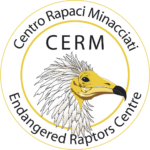CERM Endangerd Raptors Centre Association
Conservation of the Egyptian vulture and other scavenging raptors in Italy
The project aims at restocking the Italian population of the Egyptian vulture by putting in place concrete conservation actions which can also reduce the impact of serious threats affecting the species. The main actions are the following: captive breeding of the species at the CERM (Endangered Raptors Centre, in southern Tuscany), release into the wild in southern Italy of captive-bred juveniles by the hacking method, monitoring of the released Egyptian vultures by GPS/GSM devices, setting up of feeding sites close to release sites, breeding areas and along the migratory route, managing of a network of volunteers for the monitoring and support of the tagged released vultures (rescue of E. vulture in trouble, setting up of feeding sites “ad hoc”, etc. ).
The supply of food will favour the breeding success of the wild pairs, support the released juveniles and help reduce human-related mortality factors by limiting the movements for the search of food in sensitive sites (electrocution, poaching and poisoning).
The CERM’s breeding program has achieved remarkable success. Between 1993 and 2023, the Centre produced 75 chicks, with 73 reaching fledging age. In total, 51 captive-bred juveniles have been released into the wild in Italy, primarily in the Apulia, Basilicata, and Sicily regions.
51 captive-bred juveniles were released into the wild in Italy. During 2003-2023 the CERM Association released into the wild 51 captive-bred individuals..
The CERM Association has long supported the supply of food in a feeding site in Basilicata which is used by released and wild Egyptian vultures and by hundreds of red kites, black kites and marsh harriers. The Association set up a feeding site in western Sicily, inside a reclaimed waste dump, located in western Sicily, it is used by wild and released Egyptian vultures and hundreds of black kites, marsh harriers, lesser spotted eagles, etc.
In Tuscany they supported the successful reintroduction of the Red kite and continues managing a feeding platform, mainly used by the new established Red kite population.
The CERM Associations has established a network of ornithologists, volunteers, etc. that monitors in the field and supports the released vultures.
Setting up and management of feeding stations.
Measures aiming at reducing anthropogenic the impact of relevant threats (i.e., electrocution).

The project aims at restocking the Italian population of the Egyptian vulture by putting in place concrete conservation actions which can also reduce the impact of serious threats affecting the species. The main actions are the following: captive breeding of the species at the CERM (Endangered Raptors Centre, in southern Tuscany), release into the wild in southern Italy of captive-bred juveniles by the hacking method, monitoring of the released Egyptian vultures by GPS/GSM devices, setting up of feeding sites close to release sites, breeding areas and along the migratory route, managing of a network of volunteers for the monitoring and support of the tagged released vultures (rescue of E. vulture in trouble, setting up of feeding sites “ad hoc”, etc. ).
The supply of food will favour the breeding success of the wild pairs, support the released juveniles and help reduce human-related mortality factors by limiting the movements for the search of food in sensitive sites (electrocution, poaching and poisoning).
The CERM’s breeding program has achieved remarkable success. Between 1993 and 2023, the Centre produced 75 chicks, with 73 reaching fledging age. In total, 51 captive-bred juveniles have been released into the wild in Italy, primarily in the Apulia, Basilicata, and Sicily regions.

51 captive-bred juveniles were released into the wild in Italy. During 2003-2023 the CERM Association released into the wild 51 captive-bred individuals..
The CERM Association has long supported the supply of food in a feeding site in Basilicata which is used by released and wild Egyptian vultures and by hundreds of red kites, black kites and marsh harriers. The Association set up a feeding site in western Sicily, inside a reclaimed waste dump, located in western Sicily, it is used by wild and released Egyptian vultures and hundreds of black kites, marsh harriers, lesser spotted eagles, etc.
In Tuscany they supported the successful reintroduction of the Red kite and continues managing a feeding platform, mainly used by the new established Red kite population.
The CERM Associations has established a network of ornithologists, volunteers, etc. that monitors in the field and supports the released vultures.

